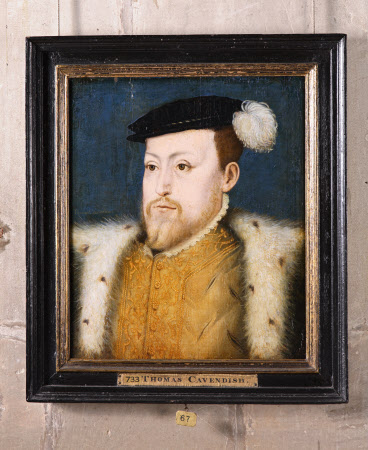King Philip II, King of Spain (1527 – 1598)
British (English) School
Category
Art / Oil paintings
Date
1500 - 1599
Materials
Oil on panel (oak)
Measurements
441 x 368 mm (17 ⅜ x 14 ½ in)
Place of origin
England
Order this imageCollection
Hardwick Hall, Derbyshire
NT 1129159
Caption
Philip II was the son of Charles V and Isabella of Portugal, who in 1554 married Mary Tudor. During his lifetime he held power over Spain, Portugal, Sicily, Naples, and, nominally, through his marriage to Mary, England and Ireland. Philip took on the mantle of defender of Catholic Europe, in an era when the Ottoman Empire was at its peak, and great battles on land and sea were fought under his command. This portrait appears to be derived from a lost portrait painted by Antonis Mor, some time between July 1554 and August 1555.
Summary
Oil painting on oak panel, King Philip II, King of Spain (1527 – 1598), British (English) School, 16th century. Falsely inscribed mid-left, in antiquarian hand: Thomas Caundisius. A head-and-shoulders portrait as a young bearded man, half length, turned slightly to left, wearing buff doublet embroidered with gold braid, ermine cloak, fur collar and black cap with white feather; blue background. This copy appears to derive from a lost portrait of him painted by Antonis Mor when he and the prince were in England, some time between July 1554 and August 1555.
Provenance
In inventory of the contents of Hardwick Hall made in 1601 and attached to the will of Elizabeth Hardwick,Countess of Shrewsbury (c.1520-1608); and thence by descent until, following the death of Edward William Spencer Cavendish, 10th Duke of Devonshire (1895 - 1950), Hardwick Hall and its contents were accepted by HM Treasury in part payment of death duties and transferred to the National Trust, in 1959
Credit line
Hardwick Hall, The Devonshire Collection (acquired through the National Land Fund and transferred to The National Trust in 1959)
Marks and inscriptions
mid-left in an antiquarian hand Thomas Cavendishius
Makers and roles
British (English) School, artist

